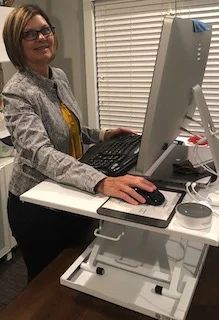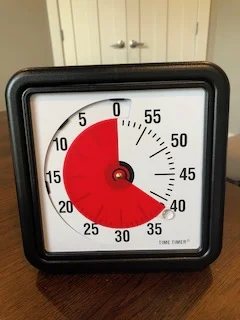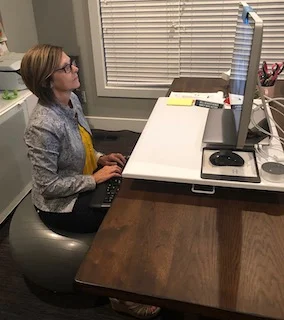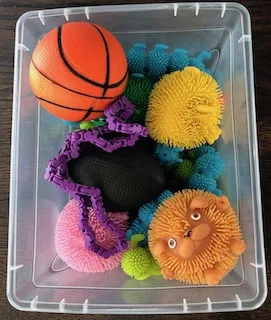Monday, September 30, 2019
welcome to the leADDership brief
A weekly newsletter for creative and innovative people, like you, with ADHD who want timely, helpful, and interesting resources
for leading and living well with ADHD.
ADHD
And Your Workspace
Office Space
Prior to starting my own coaching practice I worked for a large church and while I had an office and “desk work” that needed to be done, much of my job required me to be out of my office, meeting people, organizing events, teaching, etc. There was a lot of variety and activity in my day. I loved it. My ADHD symptoms were not overly aggravated until I had to attend long meetings without breaks or sit in front of my computer answering emails and doing administrative tasts. Torture!
So, when I resigned, re-trained, re-tooled, and re-envisioned my life as a solo-preneur, I was unprepared for just how much my, until this point un-diagnosed ADHD, symptoms would rear their head and demand my attention.
Working all day in my home office had many benefits and I was thrilled to work with the amazing client base I was building, and, I was almost derailed by how overwhelmed, bored, un-motivated, distracted, and tortured I felt showing up every day in an office that was just me, a desk, a chair, a computer, and a window. Thank God for that window!
I found myself delaying getting to work longer and longer every morning. When I got to my office I would often procrastinate getting tasks and projects done that needed my attention until the clock was ticking down, the adrenaline kicked in, and I had some brain-chemical motivation to do something.
But then I would get side-tracked by a thought or interesting idea if I was researching for a project or client. The progression had predictable results:
Interesting idea found in a blog post or article
Click on hot link in article
Click on more hot links
Have a dozen or more tabs open
Ad for flowers pops up on the side-bar—remember I forgot to water plants
Go out to water plants
See that the mail has come so grab mail—remember I have a birthday card to send
Go back in to find the card to put in mailbox—pass laundry room and remember there is a load in the washer
Stop to put clothes in dryer and load washer—feel hungry
Go to kitchen for a snack, realize it’s almost noon so decide to have lunch
While in the kitchen see office door and try and remember why I left my office and what I was doing before I left—can’t remember—eat lunch
Sometimes this would consume 30 minutes of lost time and sometimes hours. All in an attempt to jog my brain out of the motivational inertia and task avoidance I was experiencing.
Months into this I began to take note of my patterns of behavior, feelings, what I was doing instead of work, what I was experiencing while working. After doing some research, talking with friends with diagnosed ADHD, and my Doctor, I decided to be tested for ADHD and was officially diagnosed in 2014 with Combined Type ADHD: Anxious and Overfocused. It was a revelation. I now had a name for what I was experiencing and could pursue strategies and techniques to help me thrive and grow as a solo-preneur and coach.
I’ve shared in an earlier edition of the leADDership brief that when I hired my first ADHD coach my first goal was improving time-management. Read more here.
Within that goal was learning more about ADHD and the tools that help adults with ADHD thrive and succeed. Out of the research I found several tools that have improved my office experience and helped me to thrive as a solo-preneur.
Here are my top four recommendations for creating an office space that is ADHD friendly and will improve your sense of well being in your office space, whether you work from home or in a large corporate environment.
Product recommendations and links will be under “What Else Do You Need To Know.”
A Stand-Up Desk
For most adults with ADHD sitting for long periods of time can be torturous. We are often fidgety, shifting positions, tapping our feet, bouncing a leg up and down, clicking a pen, anything to relieve the pressure of feeling captured and held by the chair and desk or table in front of us.
I’ve written about focus, attention, and getting things done in previous editions of the leADDership brief so I’m not going to say much more here other than this: the feelings, emotional, mental, and physical, of being trapped behind a desk in a chair is real for adults with ADHD, you are not making it up nor are you too sensitive. We think best, focus better, problem solve best, produce more, and are more peaceful and calm when we can fidget, move, and/or pace.
“Researchers and medical experts are now linking ADHD symptoms to PHYSICAL INACTIVITY and concluding that sedentary lifestyles amplify ADHD symptoms. Researchers are also now beginning to explore the connection between too much sitting and general inactivity and the rapid increase in Attention Deficit Hyperactivity Disorder (ADHD) diagnoses. The hypothesis for that increase in diagnoses, whether or not they really have it: the amount of time kids are sitting.”
The people over at Stand Up Kids have some really great research and articles about the benefits of standing and using stand-up desks especially for people with ADHD.
You can spend a little or a lot on a stand-up desk. The one I use is on the lower-end of the scale, around $150 on Amazon, and sits directly on top of my existing desk with no confusing installation or cryptic directions required. Open box, remove desk, put on top of desk. My kids gave it to me for Christmas and I love it. It has an easy to use hydraulic lift system and I can switch from sitting to standing in a matter of seconds.
The most profound benefit of standing up is that it helps to regulate ADHD symptoms meaning a Stand-up Desk or simply standing to work can increase our:
Focus and motivation
Productivity
Problem solving
Creativity
Sense of well being and enjoyment at work
I have only my experience and the self-reporting of several of my clients who use stand-up desks, but we’ve found that using a stand-up desk and a balance ball chair helps reduce the symptoms of restless leg at night and the “jimmy leg” during the day.
Lastly, just knowing that we have options, that we can go from sitting to standing and back again, relieves anxiety.
Time Timer
I’ve mention the Time Timer often and it’s been one of the best tools I’ve invested in. Self-regulation, our short time horizons, and the challenge of making a smooth transition from “now” to “not now” are realities for us, especially at work and in an office setting. The Time Timer helps us to manage our experience with time better and to our advantage.
I’ve found the Time Timer increases my productivity by creating a sense of urgency and keeping me on track. It also signals to my brain that a break is coming reducing anxiety because I know I can do something else for awhile if I want. Or, if I’m in the zone and want to keep going I can reset the timer for another block of time.
The makers of the Time Timer recommend using it throughout your work day for project management, appointments, task management, breaks, and team meetings. Then, set it to make sure you get out the door and home on time!
To use your Time Timer you set it for the amount of time you choose which starts as a solid red color. As time goes by, the red starts to sip away giving you a clear visual of how much time you have left to work with. I like that all the white space behind it also signals how much time I’ve put into being productive.
Time Timer has clocks, watches, and apps available on their website. I use both the app on my phone and a physical clock in my office.
Based soaly upon my own experience and other’s self reporting, #1 benefit of the Time Timer for me and my clients has been in the area of procrastination.
Dr. Tim Pychyl, PhD, head of the Procrastination Research Group says that procrastination is the struggle between our amygdala (which controls our emotional and behavior responses) and our pr-frontal cortex (which controls executive function and self-regulation). If we’re procrastinating, he says, we’re experiencing "a dance between the amygdala or the limbic system, the emotional brain, and the prefrontal cortex. When we procrastinate it’s because we encounter something we find boring and unappealing and we don’t want to do it because it's not stimulating, its frustrating, or causes anxiety, or we’re not sure how to start. Dr Pychyl says this emotional response is rooted in our amygdala, which decides that the task is unpleasant and motivates us emotionally to avoid it.
The prefrontal cortex on the other hand is attempting to get us to ignore those negative feelings and push ahead with the task, even though it's unpleasant right now, because the rewards of getting it done are worth it.
The challenge for our neuro-a-typical brains is that our short time horizons often trick us into thinking the consequences of not getting something done are further away than they really are.
What the Time Timer does, with its visual of time literally slipping away, is help to jog our brains out of it’s limbic-lag and motivational inertia into action. We get a shot of adrenaline when we see that little sliver of red disappearing on the clock and are moved to action.
I first used mine in the morning to re-set my morning routine after leaving my job in a big building with lots of people, variety, and a schedule. With no-one time-checking me I was free to get to my office whenever I darn well pleased, which wasn’t great for business. Or my sense of self and well being.
I need an hour of quiet time before the day starts but when I became a solo-preneur and working from home this hour often bled into two hours.
To reset my brain I set the Time Timer for a 60-minute count down before I needed to start getting ready in the morning. Noticing the red slipping away helped me have a sense of urgency as I saw the ship getting closer to shore and it signaled to my brain that it was time to transition from quiet time to getting ready time. I would reset the timer for another hour as I got ready. This helped with the transition from getting ready to going to work.
After about a month of doing this consistently I was able to reset my morning routine and get back on track.
When we moved to Iowa four years ago my routine was all out of whack for a while and I went back to this strategy to reset my work day in my new environment.
For you audio learners, the Time Timer has both audio and visual options.
I use a Balance Ball or Stability Ball chair for all the same reasons I use a Stand-up Desk. Before I even invested in the chair I was using my big stability ball to sit on during the day. These chairs encourage you to bounce, tilt, and roll, all micro-movements that help promote enhanced concentration through body stimulation. You can spend a little or a lot on a chair. I have a mid-range priced chair and have been very happy with it. If you’re tall or have long legs make sure you check the height and distance between that ball and the floor or order a chair for tall people.
I’m short and I love this balance ball chair because my feet are flat on the floor so my body weight is more evenly distributed as I sit making it easier to bounce and tilt without falling over.
Balance Ball Chairs are also ergonomic so they help improve posture and core strength so bonus points.
Another reason I love my Balance Ball Chair is that its light and easy to move around so when I need a change of scenery I can wheel my chair to another space in the house and work from my laptop for a bit. I often take my Time Timer with me, set it for 45-minutes to an hour and work in a new space. This is particularly helpful in the 1:00-3:00 pm hours as they can be the graveyard shift for my brain. If I don’t have clients scheduled and it’s just paperwork or computer work my amygdala is looking for any way out of the trap of being at my desk. I often feel really drowsy and think I want a nap.
Standing up or sitting on my balance ball are helpful strategies to get me over the hump.
Fidgets & Squishy Balls
There are times you just cannot get up and pace, stand up, or sit on your balance ball. That’s when Fidgets and Squishy Balls can help. They offer similar micro-movement stimulation that a stability ball does on a much smaller scale. Improving focus and and concentration when in meetings.
Fidgets and Squishy Balls are small enough to fit in a jacket pocket, briefcase, purse, or backpack. They are quiet, so won’t disturb others in a meeting.
I keep a small tub of these in my home office, one in my briefcase, and one in my purse. When I’m feeling stuck or my amygdala has decided that the task at hand is unpleasant and is motivating me to emotionally to avoid it I will grab a squishy or fidget and pace around for awhile, allowing myself to brainstorm and blue sky what I want to do about this project or task. The act of moving combined with the micro-movement of my hand as it works the fidget or squishy ball can be enough to calm my brain and stimulate my prefrontal cortex to get back to the task or project at hand.
Fidgets and Squishy Balls reduce stress, lower anxiety, help with concentration and focus.
I’d love to hear about the tools and resources you use to enhance and improve your work day, or your stories of using any of the four tools I mentioned.
What Else Do You Need To Know?
Coach Pam














